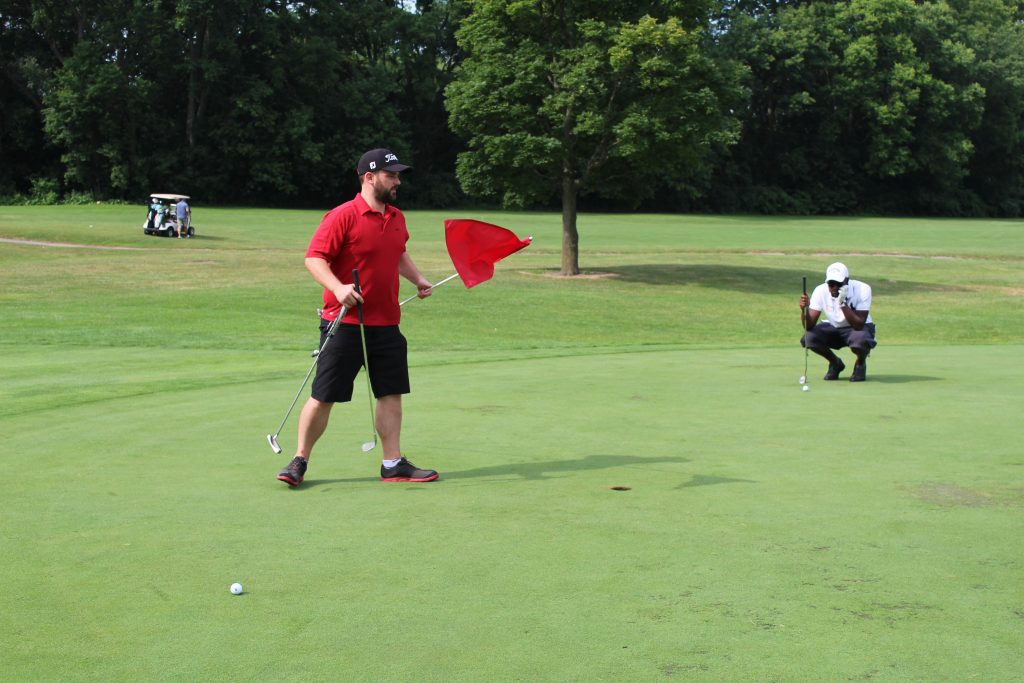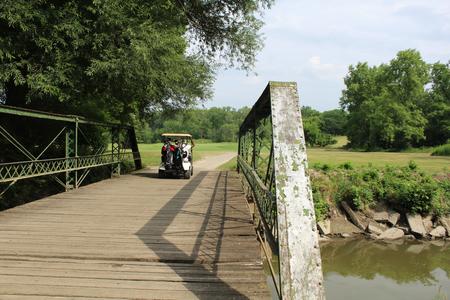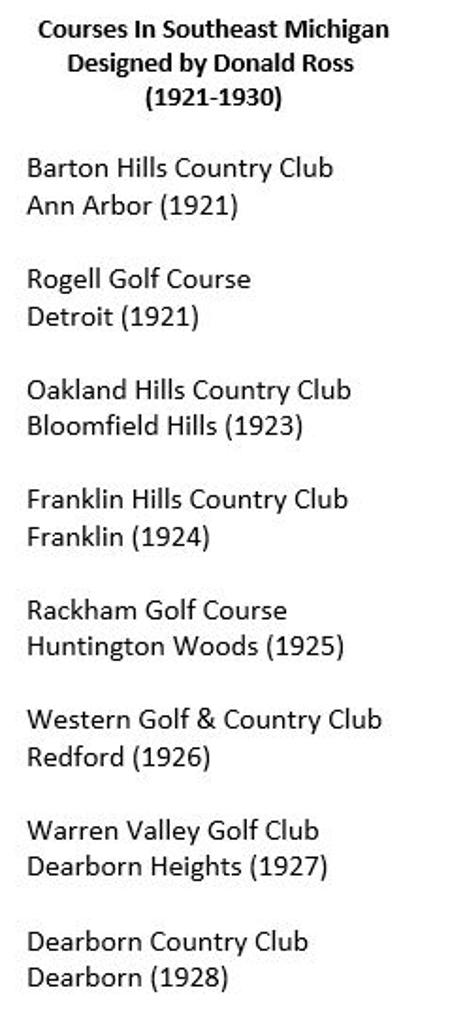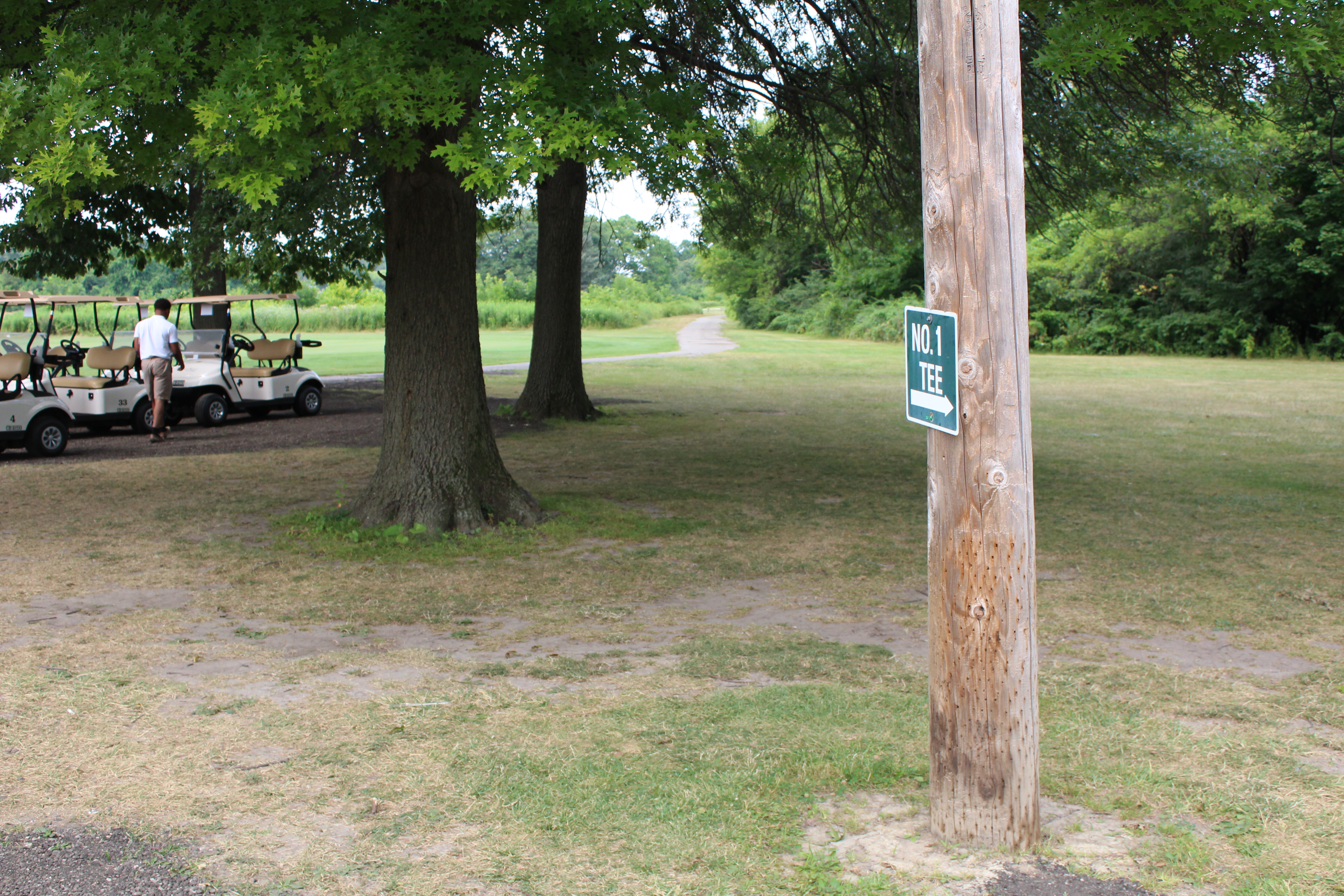CuriosiD: Who Designed the Rouge Park Golf Course?
Answering this question might prove harder than a game of putt putt.

WDET listener, Jeff Currier, is a 32-year-old golf enthusiast from Ferndale. He asked CuriosiD:
“Who designed the Rouge Park Golf Course in Detroit?”
Jeff Currier

Short Answer

With the help of Andrea Gallucci, an archivist at the City of Detroit, WDET found a map of the Rouge Park Golf Course from 1928. But, unfortunately, it did not indicate who designed the Rouge Park Golf Course.
It’s not unheard of for a golf course’s designer to be unknown. Of 84 courses known to have been built in Michigan between 1921-1930, the designers of 37 appear to be unidentified, according to a list on Michigan Golfer. This could be because records were destroyed, a designer backed out, or the course might have been designed by a city employee.
But WDET is not giving up the search! A document indicating the designer of the Rouge Park Golf Course may be out there. Read through the steps we took in trying to answer this question, and then let us know if you have any theories or leads by commenting on this post or leaving a voicemail at (248) 660-9338.
The Course

In 1923, the city of Detroit acquired land for what was — and still is — the largest park in the city: Rouge Park. Plans for the development of the natural area included amenities like swimming pools, walking trails, and 18 holes of golf.
A May 15, 1927 story published in the Detroit Free Press provided this description: “An 18-hole golf course, to be the finest public links in the city, is now under construction and will be open to the public within a year or so. This new golf course, being built over the rolling terrain of the park, with many sporty holes across water, up hill and down dale, is expected to relieve the congestion on the other municipal courses besides being one of the finest courses, public or private in the district.” SEE CLIP
The first nine holes of the course were completed in 1928, the next in 1929. Today, the par 72 course is one of three city-owned courses currently in operation, along with Rackham and Chandler Park.
The Rouge course is known for being affordable, approachable for beginners, yet still interesting for experienced golfers. The Rouge River and wooded areas not only create obstacles for golfers but a haven for wildlife. On a tour of the course, WDET spotted a bunny and what appeared to be a groundhog.
Was It Donald Ross?
The most popular theory about the course’s architect is that it was a famous, Scottish-born golf architect named Donald Ross.
A course review posted on the website GolfBlogger on July 11, 2011 proclaimed, “I ventured into Detroit to the Rouge Park Golf Course on the promise of a Donald Ross course.” Adding later in the review that “the greens all are stereotypically Ross. They’re small, round, and crowned.”


A reviewer on TripAdvisor called the Rouge Park Golf Course a “Nice Old Donald Ross Course.”
When WDET spoke to Detroit Historian Ken Coleman, he says he thought Ross designed it because the golf architect was active in the area around the time the Rouge was built.
Ross, as a designer, was prolific. He is credited with designing more than 400 golf courses nationwide, primarily from early 1900 through the 1930s. In a map created by WDET of golf courses built in Southeast Michigan between 1921-1930 (based on information from Michigan Golfer), the Rouge Park Golf Course is surrounded by courses known to be designed by Ross.
See Feb. 8, 1926 ad for the Warren Valley Golf Club that mentions other courses designed by Ross
Golf architect Raymond Hearn is familiar with the Rouge Park Golf Course because his company recently sent the city of Detroit a proposal to redesign it.
Of the course, Hearn says, “It is classic in the sense that its lay-of-the land design. Whoever designed it used the land pretty well.”
Hearn admits this is a Ross trait, but he also says it was typical of many other designers active during Ross’s time.
Overall Hearn says the Rouge Park course is nice but, “It’s not this classical gem that has never been discovered yet by someone that’s the Rembrandt or the Picasso sitting in the corner of the attic with dust on it.”
Bradley Klein, the architecture editor for Golf Channel and author of Discovering Donald Ross: The Architect and his Golf Courses says, “In many cases you don’t know you’re on a Ross course because it’s become overgrown with trees or the greens have gotten rounded off, or the bunkers have lost their shape. Even his best-designed courses have evolved dramatically [since they were first built].”
Give Me Proof
“The best way to know you’re on a Donald Ross course,” says Klein, “is there’s evidence.” In other words, you know who the designer is when it’s documented in course plans, meeting minutes, newspapers or letters.
Karen Peek, director of operations at Golf Detroit, the company contracted by the city since March to run the Rouge Park Golf Course says the question of who designed it is one that’s been asked over and over again.
“I don’t have a definitive answer for you,” Peek says. “It’s unfortunate that no one documented who it was.”
Peek previously worked for American Golf, a national company that managed the Rouge and other Detroit-owned courses for about 20 years. Back in the early 1990s, she says, American Golf tried to figure out who had designed the Rouge Park course.
“There was a significant amount of research that went on during that time to identify some of the selling points, anything of notoriety about these golf courses.” But, she says, the research did not turn up the Rouge course’s designer.
Additionally, the course is not on the official list of Ross-designed courses maintained by the Donald Ross Society. Nor is there any record of it in the Donald Ross collection in the Tufts Archives in North Carolina.
A search in newspaper archives from the 1920s turned up several references to the park and the course, yet none mentioned a course designer, Ross or otherwise.
INTERACTIVE MAP: The green icon marks the Rouge Park Golf Course. Icons in red denote Ross-designed courses.
If Not Donald Ross Then Who?
WDET created a map of golf courses built in southeast Michigan between 1921 – 1930. The information comes from Michigan Golfer and has not been independently verified by WDET. From the map, WDET broke down a list of architects who designed golf courses in Southeast Michigan during that time period. Eight courses are known to have been designed by Ross, but outside of that, the most active golf architects in southeast Michigan from 1921-1930 around the time the Rouge Park course was designed were Wilfrid Reid, with four courses, and H. S. Colt & C. H. Alison, with two courses.
Designers of Southeast Michigan Golf Courses Besides Donald Ross (1921 – 1930)
H. S. Colt & C. H. Alison
Plum Hollow Country Club, Southfield (1923)
Country Club of Detroit, Grosse Pointe Farms (1927)
Tom Bendelow
Huron Hills Golf Course, Ann Arbor (1922)
Dan Denton
Inverness Country Club, Chelsea (1927)
William Diddel
Forest Lake Country Club, Ann Arbor (1926)
William and Michael Beaupre
Plum Brook Golf Course, Sterling Heights (1927)
Art Ham and George McLean
Knollwood Country Club, West Bloomfield (1925)
Wilfrid Reid
Indianwood Golf and Country Club, Lake Orion (1925)
Wilfrid Reid & William Connellan
Bald Mountain Golf Course, Lake Orion (1929)
Brae Burn Golf Club, Plymouth (1927)
Tam-O-Shanter Country Club, West Bloomfield (1929)
Willie Park, Jr.
Pine Lake Country Club, West Bloomfield (1921)
Thomas Shoemaker
Gowane Golf & Country Club, Harrison Charter Township (1928)
Clarence Wolfrom
Maple Lane Golf Club, Sterling Heights (1926)
The above list may be a helpful tool, but it’s probable the Rouge was designed by someone who designed no other courses in the area in the 1920s. That was the case, after all, with most of the courses listed above.
Or maybe the Rouge Park Golf Course was the project of a professional golfer.
“There were quite a number of golf professionals in the Midwest who spun off and did two, three, four golf courses,” says golf architecture expert Bradley Klein. “It could have been any of them.”
Maybe the City is Responsible
Between 1924 and 1926, articles and ads about Rouge Park mentioned that 18 holes of golf were planned as part of the development. But then in early 1926, course construction was stalled due to budget constraints.
“Enforced economy this year will limit our development work,” said the Parks and Boulevards Commissioner at the time, Henry W. Busch, in an article published in the Detroit Free Press on March 14, 1926. “I had hoped to have started on the golf course which will take two years to make it available for play but this item has been cut from the budget.”
It’s unclear what exactly had been in that budget. Perhaps it had been money to pay for a world-class architect to oversee the construction of the course. We don’t know. WDET has not been able to locate that budget.
But just months later, in a Detroit Free Press article published on May 9, 1926, the Parks and Boulevards Commissioner appears to have moved on. Henry W. Busch wrote:
“One of the outstanding features of Rouge Park development will be the laying out of the sportiest golf course in the country. At the northern end of the park is the ideal location, a rolling, natural course which obviates any excessive expenditure to develop it. Under the present plans, some preliminary work will be started on the course this year, and we expect that next spring will see the beginning of actual work.”
“The cost is estimated to be in the neighborhood of $2,000 a hole, or a total of $36,000. The course will be equipped with several unusual hazards, chief among which will be the River Rouge, winding its way through seven of the fairways.”
Henry W. Busch, Detroit Parks and Boulevard Commissioner
Notice Busch mentions present plans for “the sportiest golf course in the country,” without saying who designed those plans. Was that because the architect behind them asked to have his name removed after the budget was cut? Or was it because Busch, himself, was the designer?
Golf Architect Raymond Hearn says this is plausible. He says there were many instances across the country where municipal staff designed courses, especially if the course was being built within a city park.
“Then the Parks and Recreation director of that time period would … go ahead and undertake the design or maybe call in a couple city employees that were actually golfers to assist,” says Hearn.
A Detroit Free Press article published on May 15, 1927 calls River Rouge park “the apple of the eye of Henry W. Busch.” That same article says that after 22 years in the parks and boulevards department, Busch retired in 1927. That was just one year before the Rouge Park Golf Course opened. Perhaps designing the park was his retirement gift to himself. We may never know.
[POLL]: Who do you think designed the Rouge Park Golf Course?

Behind the Question
Ferndale resident Jeff Currier has long been a fan of the Rouge Park golf course.
“Rouge Park Golf Course is one of those ‘jewels’ in Detroit, a hidden beauty within the city borders. It’s been there through the ups and downs,” he says. “It’s a place to show and tell people that their view of the city, perhaps, needs revisiting.”
Currier remembers when his dad first took him to the Rouge Park Golf Course about ten years ago. His father had really talked up the course, especially the 11th hole. When Currier first saw it, he didn’t see what the big deal was.
“Oh the green’s just downhill,” he remembers. But then Currier took a closer look. He not only had to hit the ball a couple of hundred yards downhill, he had to somehow then hit it to the right, through the woods and across the Rouge River, and then hit it another couple hundred yards to the green.
“I lost 16 balls that day,” says Currier. “It wasn’t my best round.”
In the years since, as Currier continued to come back to the Rouge Park course, he began to wonder who had designed it. When Currier couldn’t find the answer himself, he decided to turn to CuriosiD.
For this story, we spent a morning tagging along as Currier golfed the course with his buddy, Tony Jennings. Scroll down for photos from that outing.





